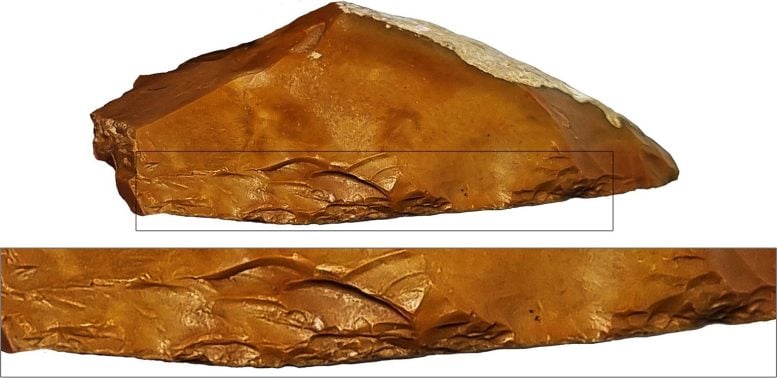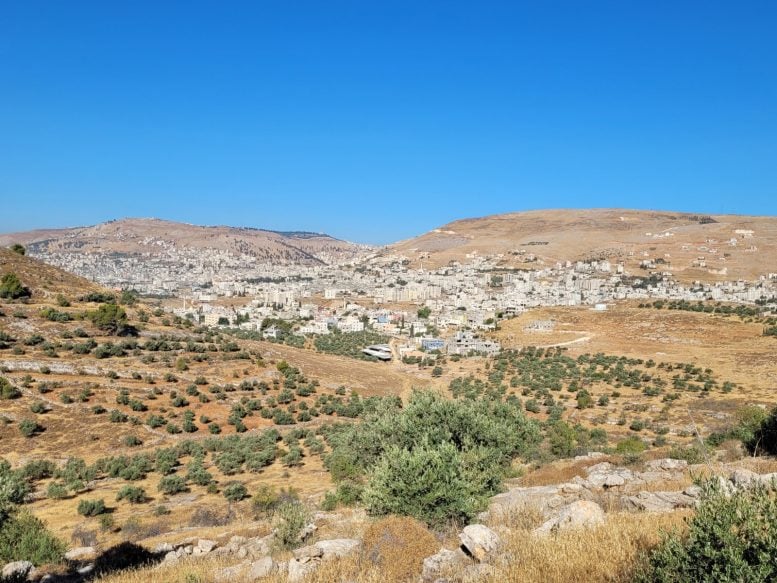
A Tel Aviv University study reveals that the earliest uses of Quina scrapers date back 400,000 years, reflecting a change in hunting practices due to the extinction of big game like elephants. Research indicates a significant cultural and practical evolution in early human societies, linking tool technology to sacred geographic sources of resources. A close look at a Quina type scraper from Jaljulia. Credit: Tel Aviv University
A study reveals that 400,000 years ago, early humans developed Quina scrapers for hunting, adapting to the disappearance of elephants and forming a cultural link with the resource-rich mountains of Samaria.
A recent Tel Aviv University study identified the world’s first use of specific stone tools called Quina scrapers, dating back 400,000 years. These tools were discovered for the first time on a site in France and bear their name. They were found at the ancient sites of Jaljulia and Qesem Cave. Quina scrapers are distinguished by their scalloped, sharp working edges, which were used for butchering deer and processing their hides.
The researchers explain that after the disappearance of elephants from the region, ancient hunters were forced to make technological adaptations allowing them to hunt, skin and process a much smaller and faster game: the deer. The study also found that the unique tools were made from non-local flint from the mountains of Samaria, which likely also served as a deer calving area, about 20 km east of Jaljulia and the cave of Qesem.
Therefore, researchers hypothesize that Mounts Ebal and Gerizim (near modern-day Nablus) were considered a source of abundance and sacred by prehistoric hunters as early as the Paleolithic period. The study was led by Vlad Litov and Professor Ran Barkai of the Jacob M. Alkow Department of Archeology and Ancient Near Eastern Cultures at Tel Aviv University. The document was published in Archeologies.
Evolution of hunting tools
Researchers explain that for about a million years, 1.5 million years ago, early humans used stone tools called scrapers to process hides and scrape flesh from bones, primarily from large game animals. In the Levant, they mainly hunted elephants and other large herbivores which provided them with most of the calories they needed. However, the study found that around 400,000 years ago, after elephants became extinct, hunters turned to another type of prey, considerably smaller and faster than elephants: the deer.

Mount Gerizim and Mount Ebal. A view from the east. Credit: Dr Shai Bar
Litov explains: “In this study, we tried to understand why stone tools changed during prehistory, focusing on a technological change in scrapers in the Lower Paleolithic, around 400,000 years ago. We saw a dramatic change in human diets during this period, likely resulting from a change in available wildlife: big game, particularly elephants, had disappeared, and humans were forced to hunt larger animals. small, especially deer. Obviously, taking down a large elephant is one thing, and processing a much smaller, more delicate deer is a whole other challenge.

Professor Ran Barkai. Credit: Tel Aviv University
Systematically processing numerous deer to compensate for a single elephant was a complex and demanding task that required the development of new tools. Therefore, we are seeing the emergence of the new Quina scrapers, with a better shaped, sharper and more uniform working edge compared to the simple scrapers used previously.
Conclusion and historical significance
The study is based on the results of an excavation carried out at the prehistoric site of Jaljulia, next to Highway 6 in central Israel, probably inhabited by humans of Homo erectus.
” data-gt-translate-attributes=”({“attribute”:”data-cmtooltip”, “format”:”html”})” tabindex=”0″ role=”link”>species, as well as evidence from the nearby Qesem Cave. On both sites, the excavators discovered numerous scrapers of a new type, in non-local flint, the closest sources of which are the western slopes of Samaria, to the east of the excavated sites, or the current forest of Ben Shemen, to the south.
Professor Barkai adds: “In this study, we identified links between technological developments and changes in the wildlife hunted and consumed by early humans. For many years, researchers believed that changes to stone tools resulted from biological and cognitive changes in humans. We demonstrate a double connection, both practical and perceptual. On the one hand, humans began to make more sophisticated tools because they needed to hunt and kill smaller, faster, finer game. On the other hand, we identify a perceptual link: Mounts Ebal and Gerizim in Samaria, approximately 20 km east of Jaljulia, were a home range for deer and were therefore considered a source of abundance. We found a connection between the abundant source of deer and the source of flint used to kill them, and we believe this connection had perceptual meaning for these prehistoric hunters. They knew where the deer came from and made particular effort to use flint from the same region to make tools for skinning this prey. This behavior is familiar in many other places around the world and is still widely practiced by indigenous hunter-gatherer communities.
Litov concludes: “We believe that the mountains of Samaria were sacred to the prehistoric people of Qesem Cave and Jaljulia, because that is where the deer came from. It is important to note that in Jaljulia we also found many other tools made from different types of locally purchased stones. When locals realized that the elephant population was declining, they gradually turned their attention to deer. Identifying the deer’s abundant source, they began developing unique scrapers in the same location. This was the first example of a phenomenon that subsequently spread across the world.
The new scrapers first appeared in Jaljulia on a small scale, about 500,000 years ago, and shortly after, 400,000 to 200,000 years ago, on a much larger scale in Qesem Cave . The Samarian highlands east of Jaljulia and Qesem Cave were likely the home range of a deer population, as evidenced by skeletal remains recovered from local archaeological sites throughout the Pleistocene and Holocene. Numerous deer bones have also been found at the altar site of Mount Gerizim, attributed in the Old Testament to Joshua bin Nun, and identified by some traditions as the location of the Covenant of Abraham’s Pieces described in the book of Genesis. Apparently, the mountains of Samaria acquired an important, even sacred, status as early as the Paleolithic period and retained their unique cultural position for hundreds of thousands of years.
Reference: “The stone, the deer and the mountain: Lower Paleolithic scrapers and first human perceptions of the cosmos” by Vlad Litov and Ran Barkai, February 23, 2024, Archeologies.
DOI: 10.1007/s11759-024-09493-w